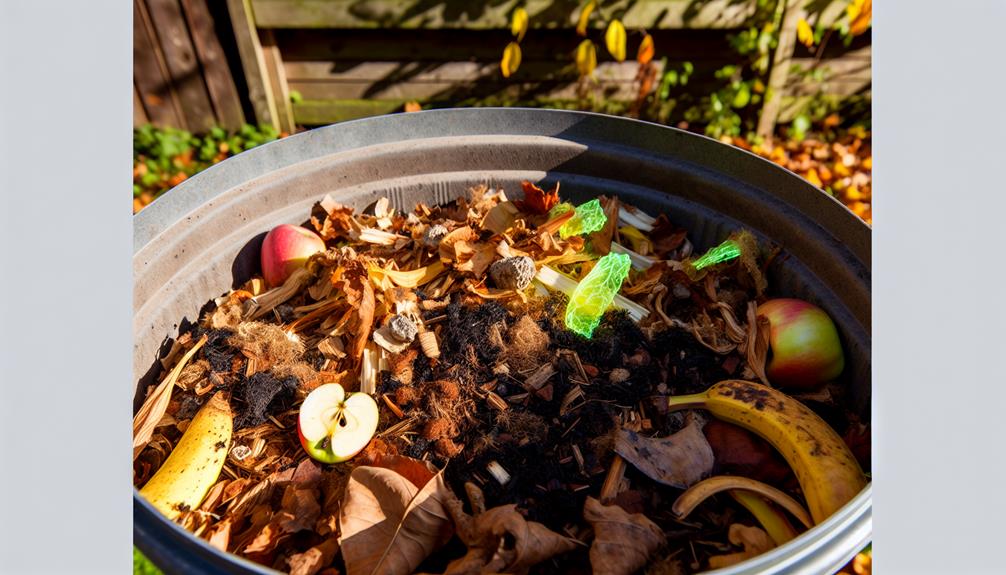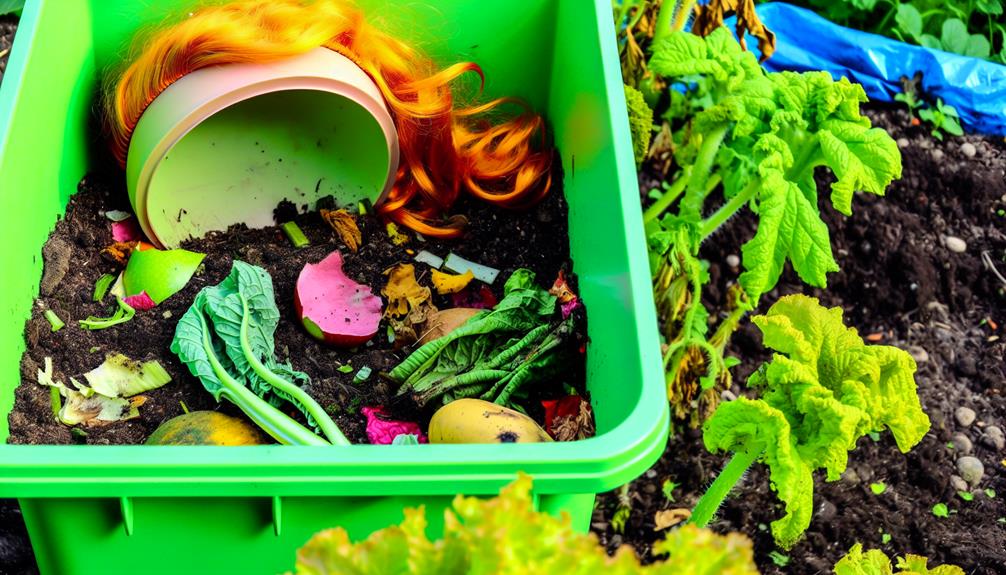

You can compost wigs made from natural materials, such as human hair. These organic fibers break down and enrich the soil with nutrients. However, synthetic wigs, crafted from plastic fibers like polyester or PVC, are non-biodegradable and shouldn’t go in your compost pile.
If you want to compost a natural wig, clean it thoroughly and cut it into smaller pieces to speed up decomposition. Alternatively, consider donating gently used wigs or recycling synthetic ones through specialized programs to minimize environmental impact. Want more detailed steps and eco-friendly disposal tips? You’re just about to find them.
When you’re thinking about composting wigs, it’s crucial to understand the materials they’re made from. Most wigs fall into two categories: synthetic and natural. Synthetic wigs are typically crafted from plastic fibers like polyester, acrylic, or PVC. These materials are derived from petroleum, making them non-biodegradable.
On the other hand, natural wigs are usually made from human hair or animal fibers, which are organic and have better composting potential.
Knowing the material sourcing and manufacturing process can help you determine if a wig is compostable. Synthetic wigs are created through a complex manufacturing process that includes melting, extruding, and cooling plastic polymers to form hair-like fibers. These fibers are then dyed and styled. Because they’re plastic-based, they don’t break down in a compost pile.
Natural wigs, however, undergo a more straightforward process. Human hair is collected, cleaned, and sometimes treated with minimal chemicals. Animal fibers, like wool or yak hair, are similarly processed. These organic materials decompose much more readily in a compost environment.
Also Read: Can You Compost Blood?
Understanding the materials wigs are made from is the first step in evaluating their environmental impact. Most wigs are crafted from either synthetic fibers or human hair.
Synthetic wigs, made from plastics like acrylic and polyester, have a substantial impact on landfill waste, as they aren’t biodegradable. Human hair wigs, while more eco-friendly, still have environmental costs related to their production and transportation.
To mitigate these impacts, consider participating in recycling programs. Some organizations specialize in recycling synthetic wigs, breaking down the materials for reuse in other products. This reduces landfill waste and promotes a circular economy.
Another way to reduce the environmental footprint of wigs is through donation options. Many charitable organizations accept gently used wigs and provide them to individuals undergoing medical treatments that cause hair loss. Donating wigs not only extends their lifespan but also helps someone in need.
When considering the biodegradability of wig components, you need to examine how synthetic fibers, natural hair, and wig cap materials break down in compost.

Synthetic fibers often take much longer to decompose compared to natural hair.
Additionally, wig caps made from different materials vary in their environmental impact, influencing how effectively they can be composted.
Synthetic fibers in wigs often pose a challenge to composting due to their low biodegradability. Unlike natural materials, synthetic fibers are usually made from plastics like polyester, acrylic, or nylon. These materials are designed for durability, which unfortunately means they don’t break down easily in a compost heap.
When you try to compost a wig made from synthetic fibers, you’re likely to end up with fiber waste that takes years, if not decades, to decompose.
However, don’t feel disheartened. There’s a growing movement towards synthetic recycling. Some companies are developing methods to recycle synthetic fibers effectively. By separating these fibers from other compostable materials, you can contribute to this recycling process.
Look for local recycling programs that accept synthetic textiles; they can transform these fibers into new products, reducing the burden on landfills.
It’s also worth considering alternatives when purchasing wigs. Opt for those made from biodegradable materials, or consider brands that offer recycling programs for their products. By being mindful of your choices and properly managing synthetic fiber waste, you can make a positive impact on the environment.
Natural hair wigs decompose much faster than synthetic ones, offering an eco-friendly alternative for those looking to minimize their environmental footprint. Human hair is biodegradable, meaning it breaks down naturally as part of the composting process. When you compost a natural hair wig, you’re returning organic material back to the earth, enriching the soil with essential nutrients.
To compost a human hair wig, start by cutting the hair into smaller pieces. This increases the surface area, speeding up decomposition. Make sure to mix the hair with other compostable materials like vegetable scraps, leaves, and paper. The blend helps maintain a balanced carbon-to-nitrogen ratio, crucial for efficient composting.
Keep your compost pile moist but not waterlogged, and turn it regularly to provide oxygen. This encourages microbial activity, which is crucial for breaking down organic matter.
In a few months, you’ll notice the hair integrating into the compost, gradually becoming part of the rich, dark humus that plants love.
Although the wig cap is often overlooked, its material greatly influences the overall biodegradability of the wig. When considering composting wigs, you need to look at the cap construction and material sourcing.
Wig caps can be made from various materials, ranging from natural fibers like cotton to synthetic ones like nylon or polyester. Natural fibers decompose more readily, making them better choices if you’re aiming for an eco-friendly disposal.
For instance, cotton or bamboo caps break down much faster than their synthetic counterparts. If you’re sourcing materials or buying a wig, it’s wise to opt for those made with natural fibers. Synthetic materials, while durable, can take years to decompose and release harmful microplastics into the environment.
Understanding cap construction is also essential. Wig caps with minimal glue and stitching using biodegradable threads enhance the composting process. Look for wigs that emphasize eco-friendly practices in their manufacturing.
Be sure to check labels or product descriptions for information on material sourcing and construction methods.
Also Read: Can You Compost Black-Eyed Peas?
When comparing wigs, you’ll find key differences between those made from synthetic fibers and those crafted from natural hair. Understanding these differences can help you make informed choices about sustainability and disposal options.
Synthetic wigs are produced from man-made fiber sources like acrylic, nylon, or polyester. The manufacturing process involves chemically synthesizing these materials to mimic the appearance and texture of natural hair. Natural wigs, on the other hand, are made from real human hair, sourced from donors. Their manufacturing process is more straightforward, involving cleaning, treating, and styling the hair.
Here’s a quick comparison:
| Aspect | Synthetic Wigs | Natural Hair Wigs |
|---|---|---|
| Fiber Sources | Acrylic, Nylon, Polyester | Human Hair |
| Manufacturing Process | Chemical synthesis | Cleaning and treating real hair |
| Appearance | Consistent but less realistic | More natural and realistic |
| Maintenance | Low maintenance | Requires regular care |
| Compostability | Generally non-compostable | Potentially compostable |
Synthetic wigs are less likely to be compostable due to their plastic-based fiber sources. Natural hair wigs, however, might be compostable because they’re made from organic material. When choosing a wig, consider both your styling needs and the environmental impact. Opt for natural hair wigs if sustainability is a key priority for you.
Also Read: Can You Compost Celery?
To start composting a wig, first identify whether it’s made from natural fibers or synthetic materials. Natural fibers like human hair can be composted, but synthetic wigs need to be handled differently.

Once you’ve determined the material, prepare the wig by cutting it into smaller pieces to speed up the composting process.
The first step in composting a wig is to identify the materials it’s made from. Wig construction varies widely, so understanding what your wig is made of is important. Start by checking the label or any packaging that came with the wig. Many wigs are made from synthetic fibers like nylon, polyester, or acrylic, which aren’t compostable. However, if your wig is made from natural materials, such as human hair, wool, or cotton, it can be composted.
Pay attention to how the wig was constructed. The cap and any additional structural elements might also contain non-compostable materials. It’s important to separate these components to make sure you’re only composting biodegradable parts. Sometimes, wigs include metal clips, plastic bands, or adhesive materials that need to be removed.
When sourcing materials, keep sustainability in mind. Wigs made from natural, ethically sourced materials are better for the environment and easier to compost. If you’re unsure about a particular material, a quick online search can provide clarity.
Kick off your wig composting process by thoroughly cleaning and separating any non-compostable elements from the wig. Start by removing any clips, bands, or synthetic fibers, as these materials won’t break down in compost. Focus on the wig’s base and strands, ensuring they’re free of non-biodegradable parts.
Next, use appropriate cleaning methods to wash the wig. If the wig is made from natural hair, you can use a gentle, eco-friendly shampoo. Thoroughly rinse to remove any residues. For wigs treated with chemical treatments, be cautious. These chemicals can hinder the composting process, so it’s essential to rinse the wig multiple times to minimize their presence.
After cleaning, let the wig air-dry completely. Moisture can cause mold and other issues in your compost pile. Once dry, cut the wig into smaller pieces. This increases the surface area, making it easier for microbes to break down the material.
Also Read: Can You Compost Basil?
Have you ever considered upcycling old wigs into art projects or household items instead of tossing them out? It’s a creative and eco-friendly solution. Start by looking into local recycling programs to see if they accept synthetic materials. Some programs are equipped to handle these fibers and can repurpose them into new products.
Another great option is to donate wigs to organizations and donation centers that specialize in distributing them to those in need. Many cancer support groups and charities accept gently used wigs and offer them to patients undergoing treatment. This not only reduces waste but also supports individuals in your community.
If you’re feeling crafty, wigs can be transformed into unique art pieces or practical household items. Think about creating textured wall art, decorative pillows, or even costume accessories.
You can also use wig fibers for doll hair or puppets, providing endless opportunities for creativity.
You’re wondering if dyed wigs can be composted safely. Since they often contain synthetic fibers and chemical treatments, they’re not suitable for composting. Opt for proper disposal methods to maintain a sustainable community.
The time it takes for a wig to decompose depends on its material composition. Natural fibers break down faster, while synthetic ones take much longer. Decomposition factors like temperature, moisture, and microbial activity also heavily influence the process.
When you compost wigs, health risks arise from synthetic materials and chemical residues. You’re part of a community that values safety, so consider potential hazards and opt for eco-friendly alternatives to protect both yourself and the environment.
You’re wondering if pet hair wigs can be composted, aren’t you? If they’re made from natural fibers, they’re compostable. However, synthetic materials won’t break down properly and could harm your compost. Stick with natural options!
You’ll know a wig is decomposing properly when you see decomposition indicators like a breakdown of natural fibers, earthy smell, and presence of microorganisms. It’s a natural process that shows you’re contributing to a sustainable environment.
To compost a wig, first identify its material. Natural fibers like human hair and wool are compostable, but synthetic fibers aren’t.
Cut the wig into smaller pieces for faster decomposition. Remove any non-compostable parts like clips or bands.
Mix wig pieces into your compost pile, ensuring they’re balanced with green and brown materials. Regularly turn the compost for aeration.
Alternatively, consider donating or recycling wigs to minimize environmental impact.
